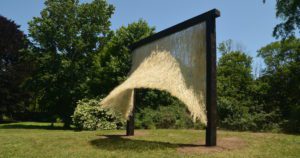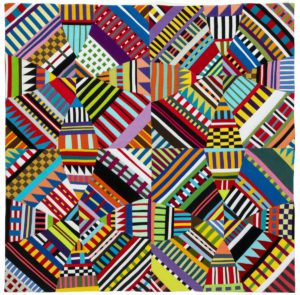FOR IMMEDIATE RELEASE
Contact: Kristen Levesque
(207) 329-3090
kristen@kristenlevesquepr.com
Final Weeks to visit Shelburne Museum for the Season – Last Day October 16
SHELBURNE, Vt. (October 3, 2022)—These are the final weeks to visit Shelburne Museum to experience the 2022 season of exhibitions, programs, and refurbished historic buildings. The museum’s final open day will be October 16, after which the museum will close and reopen at the end of November for the 2nd Annual Winter Lights celebration.
Don’t miss this special opportunity to view a major exhibition of the work of Luigi Lucioni. Luigi Lucioni: Modern Light showcases the technically sophisticated realist who favored the play of light and shadows on weathered barns and stately trees contributing to the genre termed “Yankee Modernism.” Visitors can also explore American art through the lens of eyewear. Eyesight and Insight: Lens on American Art explores the ways in which eyesight, vision, and eyeglasses played a role in the history of American art. Two of the museum’s historic buildings Stagecoach Inn and The Dana-Spencer Textile Galleries at Hat and Fragrance, reopened this year after updates and conservation. In addition, the museum’s campus has been enhanced with two outdoor sculptural experiences: four monumental post-and-beam structures by Nancy Winship Milliken and the permanent collection acquisition, Faceted Rock, is a large-scale steel sculpture by Vermont-based sculptor David Stromeyer. Maria Shell’s contemporary quilts have also been a fan favorite with visitors this summer.
2022 exhibitions include:

Luigi Lucioni: Modern Light (Through October 16) examines the career, influences, and techniques of Italian-American artist Luigi Lucioni. A prolific painter and printmaker, Lucioni is known today for his landscape paintings, still-life works, portraiture and etchings. Modern Light is the first comprehensive exhibition of the artist’s work at a major public museum, as well as Shelburne Museum’s first monographic exhibition of Lucioni’s art since 1968. Known during his lifetime as a technically sophisticated realist who favored the play of light and shadows on weathered barns and stately trees, Lucioni contributed to the genre that art historian Bruce Robertson has termed “Yankee Modernism.” Lucioni, along with Paul Sample, Maxfield Parrish, and even Charles Sheeler and Andrew Wyeth, depicted a landscape and a people, orderly yet odd, who embodied an idealized set of “American” values in an era of great social and political change.
 Eyesight and Insight: Lens on American Art (Through October 16) illuminates the history of creative response to perceptions of vision and invites new insights into the ways American artists have negotiated issues related to eyesight from the 18th to the 21st century. The exhibition features objects from Shelburne Museum’s collection as well as significant loans including works by Rembrandt Peale, George Cope, Tseng Kwong Chi and others. Surveying more than 200 years of art and technological innovation, this marks the first major museum exhibition and scholarly publication considering the myriad roles of eyeglasses and optical technologies in the history of American art. A virtual component to the exhibition is on view on the museum’s website. To explore the online galleries, visit: www.shelburnemuseum.org/online-exhibitions/eyesight-insight/
Eyesight and Insight: Lens on American Art (Through October 16) illuminates the history of creative response to perceptions of vision and invites new insights into the ways American artists have negotiated issues related to eyesight from the 18th to the 21st century. The exhibition features objects from Shelburne Museum’s collection as well as significant loans including works by Rembrandt Peale, George Cope, Tseng Kwong Chi and others. Surveying more than 200 years of art and technological innovation, this marks the first major museum exhibition and scholarly publication considering the myriad roles of eyeglasses and optical technologies in the history of American art. A virtual component to the exhibition is on view on the museum’s website. To explore the online galleries, visit: www.shelburnemuseum.org/online-exhibitions/eyesight-insight/
 Commissioned to celebrate the museum’s 75th anniversary, Nancy Winship Milliken: Varied and Alive (Through October 16), is a site-specific outdoor sculpture exhibition that embodies the Museum’s commitment to environmental stewardship and sustainability while also engaging in global and local ecological conversations, from climate change to Lake Champlain’s watershed history. Installed within a pollinator meadow planted for this exhibition, Winship Milliken’s four monumental post-and-beam structures feature different natural materials intrinsic to the land, all of which explore themes related to sustainability: horsehair, wool, beeswax and driftwood. Activated by the wind and sun, each sculpture uniquely moves, changes and adapts to the environment, inspiring community conversations surrounding our roles within and relationships to nature.
Commissioned to celebrate the museum’s 75th anniversary, Nancy Winship Milliken: Varied and Alive (Through October 16), is a site-specific outdoor sculpture exhibition that embodies the Museum’s commitment to environmental stewardship and sustainability while also engaging in global and local ecological conversations, from climate change to Lake Champlain’s watershed history. Installed within a pollinator meadow planted for this exhibition, Winship Milliken’s four monumental post-and-beam structures feature different natural materials intrinsic to the land, all of which explore themes related to sustainability: horsehair, wool, beeswax and driftwood. Activated by the wind and sun, each sculpture uniquely moves, changes and adapts to the environment, inspiring community conversations surrounding our roles within and relationships to nature.
 Maria Shell: Off the Grid (Through October 16) features 14 works by Shell created between 2011 and 2022 that explore the ways the artist pushes the boundaries of the traditional gridded format of the American quilt. Shell produces contemporary quilts grounded in the tradition and craft of American quilt making. She takes classical components of traditional bedcovers and manipulates them to create surprising combinations of pattern, repetition and color.
Maria Shell: Off the Grid (Through October 16) features 14 works by Shell created between 2011 and 2022 that explore the ways the artist pushes the boundaries of the traditional gridded format of the American quilt. Shell produces contemporary quilts grounded in the tradition and craft of American quilt making. She takes classical components of traditional bedcovers and manipulates them to create surprising combinations of pattern, repetition and color.
 Newly installed this summer is the work of Vermont-based sculptor David Stromeyer. This permanent collection acquisition, Faceted Rock, is a large-scale steel sculpture has been prominently placed on the museum’s grounds near the Meeting House building and joins the museum’s outdoor sculpture collection. The 46 facets of this monolith feature a metallic paint that fractures natural light across its bold geometry, highlighting its abstract form. Epitomizing Stromeyer’s expressive and technical dexterity working with steel, Faceted Rock embodies the soul and identity of place and maker.
Newly installed this summer is the work of Vermont-based sculptor David Stromeyer. This permanent collection acquisition, Faceted Rock, is a large-scale steel sculpture has been prominently placed on the museum’s grounds near the Meeting House building and joins the museum’s outdoor sculpture collection. The 46 facets of this monolith feature a metallic paint that fractures natural light across its bold geometry, highlighting its abstract form. Epitomizing Stromeyer’s expressive and technical dexterity working with steel, Faceted Rock embodies the soul and identity of place and maker.
Image captions:
1) Aerial view of Shelburne Museum’s campus of 39 buildings across a 45-acre campus.
2) Luigi Lucioni, Village of Stowe, Vermont, 1931. Oil on canvas, 23 1/2 x 33 1/2 in. Minneapolis Institute of Art, Gift of the Estate of Mrs. George P. Douglas. Licensed by Bridgeman Images.
3) Edwin Romanzo Elmer (American, 1850–1923), Magic Glasses, 1891, Oil on canvas, 14 x 10 in., Collection of Shelburne Museum, Museum purchase, acquired from Richard Gipson. Photography by Bruce Schwarz.
4) Nancy Winship Milliken, Pasture Song, 2018-22. Charred wood post and beam, fishing net, white horsehair, and hardware, 15 x 17 ft. Courtesy of the artist.
5) Maria Shell, Everything All At Once, 2019, cotton, 58 x 58 inches. Courtesy of the artist. Photography by Chris Arend.
6) David Stromeyer, Faceted Rock, 2004. Steel, epoxy, and metallic paint, 8 1/2 x 9 x 11 3/16 ft. Collection of Shelburne Museum, museum purchase, made possible by a gift from Todd R. Lockwood.
Hi-res images available upon request.
About Shelburne Museum
Founded in 1947 by trailblazing folk art collector Electra Havemeyer Webb (1888–1960), Shelburne Museum in Shelburne, Vermont, is the largest art and history museum in northern New England and Vermont’s foremost public resource for visual art and material culture. The Museum’s 45-acre campus is comprised of 39 buildings including the Pizzagalli Center for Art and Education and Webb Gallery featuring important American paintings by Andrew Wyeth, Winslow Homer, Grandma Moses, John Singleton Copley and many more. For more information, please visit shelburnemuseum.org.
###

